
Home page
Standard model is unreal
QED is wrong
Dirac equation is unreal.
(Fig.1) The present particle physics pursues only useless illusory particles ↓

The present particle physics based on unphysical standard model has pursued only useless illusory particles such as Higgs, W, Z bosons, fractional-charge quarks, antiparticles, muons and extra-dimensions.
↑ All these illusory unstable particles are useless (= unstable muons are just high-energy penetrating electrons or protons, positron emission is just electron capture ), just ended up wasting taxpayers' money in meaningless gigantic colliders.
↑ "Unnecessary particles" means "non-existent particles" which are just background artifact or other irrelevant particles.
(Fig.2) Precise measurement of all energies of final products is necessary to prove standard model or too short-lived Higgs, W,Z bosons, quarks, which is impossible because of too low detection efficiency of energy detectors of particle colliders.

The present particle physics pursues only useless illusory particles which are too short-lived to detect ( this or this-p.4-last ).
These illusory short-lived particles such as Higgs, W,Z bosons, quarks, muons.. are said to be transiently produced by protons' collision, and immediately decay into final detectable stable particles such as electrons and lights (= photons ) through virtual unstable intermediate particles ( this-p.14-16 ) and jets.
The present particle physics or unphysical standard model is unsuccessful (= with No evidence ), unable to predict anything due to its artificially-chosen free parameters such as the illusory unstable particles' masses and coupling parameters ( this-p.66-68 ), contrary to hypes.
The proof and the measurement of the masses of these ( illusory ) short-lived particles needs the precise measurement of all energies of all final products such as light (= photons ) and electrons (= leptons ) into which these short-lived particles decay.
↑ By precisely measuring all energies of all final particles, they have to show some energies (= or masses ) are detected slightly more likely than other irrelevant background energies to (baselessly) prove the (illusory) short-lived particles' existence and masses, which is impossible.
Physicists have to artificially ignore almost all particle collision data as background signal irrelevant to production of those (illusory) short-lived, rare particles such as Higgs, W,Z bosons, quarks ( this-p.2-last,p.6 ), and adjust free background parameters ( this-p.2-3rd-paragraph, this-p.8-last, this-8~14th-paragraphs ).
This-6. says
"The Higgs boson cannot be observed directly because its lifetime is too short for our apparatus... the boson decays and transforms into other particles, and the detectors may detect these decay products. As an example, one of the ways a Higgs particle can decay is into two photons (= light ), which can then be detected. However, there are many other (= irrelevant ) processes that also produce two photons, so researchers compare the number of so-called "two-photon events" measured with the number expected from known processes. They do this for all the possible decay modes, and only when they see a statistically significant excess of events can scientists claim a discovery." ← Not detecting (illusory) Higgs itself
The problem is the detection efficiency (= called quantum efficiency = QE ) of photodetectors of particles colliders are too low ( less than 30% = more than 70% of photons or energies are lost, undetectable ), which can detect almost No lights' (or photons' ) energies ( this-p.3,4,14,15, this-p.23-24 ).
↑ Photodetectors can detect only a small fraction of visible lights, and almost all lights with almost all wavelengths except only part of visible lights are undetectable and lost ( this-p.57-Figure 5.19 ). ← All the high-energy γ, X rays, infrared light, heat are undetectable, invisible by particle colliders.
This-p.15-3rd-paragraph says
"The quantum efficiency depends on the type of photodetector used to detect the scintillation
light, which is typically ∼15–30% for photomultiplier tubes (= more than 70% photon or light energies are undetectable ).. The response of the detector is usually highly wavelength dependent (= all high-energy gamma rays, X rays and heat are undetectable )"
↑ As a result, today's particle colliders' detectors' efficiency is too low or too bad to validate (unphysical) standard model's prediction (= prediction of the unreal W boson mass by precisely measuring all energies of all final decay products is impossible ).
Almost all energies of particles, electrons are lost as heat, which are undetectable and invisible, inside particle colliders ( this-p.53, this-p.27-2nd-paragraph, this-overview, this-p.13-14 ).
This (or this )-p.10-iii), p.18-2nd-last-paragraph say
"Only a fraction of the photons reach the photocathode. The rest is either absorbed inside crystal (= almost all photons or lights are undetectable )"
"In a sampling calorimeter, most of the soft shower electrons will Not contribute to the signal.. more than 80% of the 1 MeV electrons.. will Not manage to reach a sensitive plane"
Physicists often rely on artificial background models ( this-p.1-left-lower ) and unreliable random guess called Monte Carlo (= MC ) method to baselessly estimate the lost energy instead of directly measuring energies ( this-p.4, this-p.5-lower, this-p.39-lower ), which are Not real experimental values ( this-p.13-15 ).
So it is impossible to precisely measure energies (= masses ) to prove the existence of the short-lived particles such as Higgs, W,Z bosons, quarks, muons.., hence, No experimental evidence of (unphysical) standard model, contrary to hypes.
(Fig.3) Unseen virtual Z, W bosons mediate illusory weak interaction between unseen neutrinos and electrons ? ← This is impossible to prove.
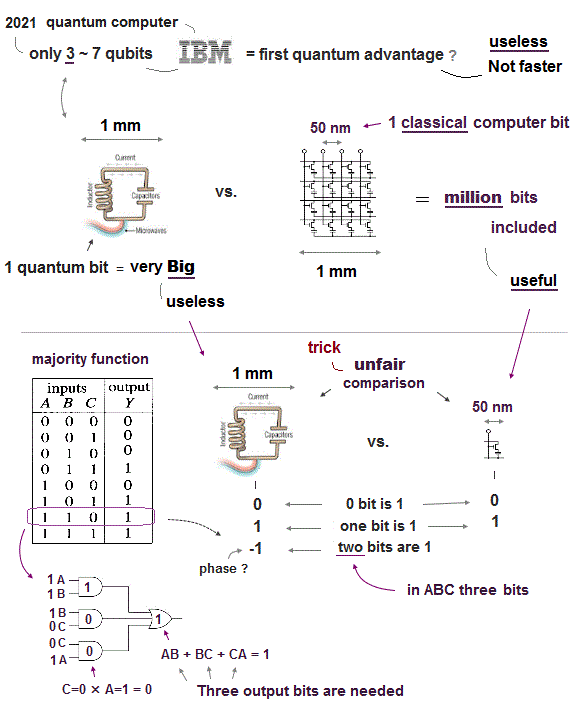
The neutral ( illusory ) very heavy Z boson, which is too short-lived to detect, is said to mediate the unseen neutrinos (= ν ) interacting with electrons (= e- ) or other particles in the ad-hoc weak force called neutral current (= NC ).
↑ Today's standard model paradoxically says the initial neutrino with only 1 ~ 10 GeV energy ( this-p.2-right, this-p.9 ) can generate much heavier ( unseen ) Z boson with larger 90 GeV energy (= neutral current, this-p.55 ), which clearly violates energy-mass conservation law, which means Z boson is just an unreal virtual particle ( this-p.6 ).
W bosons, which are also short-lived, undetectable illusory particles, are said to mediate electrons and neutrinos in beta decay, which is called charged current (= CC ).
By measuring the ratio of these illusory neutral Z boson (= NC ) to W bosons (= CC ) interactions in (unseen) neutrinos weak force reactions, the standard model's (unphysical) Weinberg mixing angle θW parameter (= free parameters ) is said to be estimated through the artificial definition ( this-p.23-28 ).
But measuring the unseen neutrinos or their elusive reactions is extremely difficult ( this-p.20-lower ).
They baselessly say the (illusory) neutral Z bosons often interact only with nuclei (= hadrons, this-p.3-Z decay mode ), while the charged W bosons interact with charged particles such as electrons and muons in the unseen elusive neutrino scattering experiments.
But it is impossible to distinguish the reactions of these (illusory) Z and W bosons, both of which can interact with the same charged particles such as electrons e-.
So their claim of measuring Weinberg weak mixing angle based on this elusive neutrino scattering is unreliable, unable to validate the (unphysical) standard model (= Glashow-Weinberg-Salam, GWS electroweak theory, this-p.3 ).
This paper doubting the present standard (= GWS = Glashow-Weinberg-Salam ) model ↓
p.2-last says "empirical accuracy was Not sufficient for choosing the GWS (= standard ) model (= standard model or GWS theory was false )."
p.10-3.1 says "On these pictures, only charged particles are visible. Neutral particles and interactions, like the NC are not (= neutral Z boson reactions, neutrinos.. are invisible, which can hardly prove the standard model )"
p.17-2nd-paragraph says "What was needed for determining the ( unphysical ) Weinberg angle of the GWS model, however, were separate NC/CC (= neutral current of Z boson/ charged current of W boson ) ratios to be obtained on the basis of separate neutrino (R) and antineutrino (Rbar) beams"
"This result.. was in fact inconsistent with the predictions of the GWS model.. However, this negative published result was largely ignored (= experiments disproving the standard model were ignored )"
p.18-middle says "Furthermore, the Weinberg mixing angle that was determined.. in the early 1970s was 0.38; it now is 0.23. Prima facie, this sheds significant doubt on the accuracy of the results in 1973/4 ( this-p.18 ) ← Precise measurement of Weinberg angle based on elusive neutrino scattering was impossible, giving inconsistent values."
↑ Particle physics experiments are too unreliable to validate the standard model.
(Fig.4) They try to estimate the (illusory) heavy W boson mass allegedly generated from the much lighter muon through artificial definition, which is paradoxical, wrong.
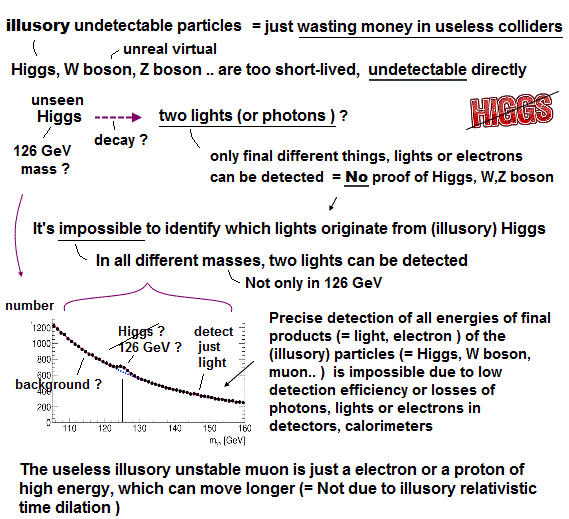
Today's particle physics based on standard model relying on many freely-adjustable parameters is useless, unable to predict physical values, contrary to hypes ( this-p.13 ).
The imaginary supersymmetry model needs more than 100 free parameters that can Not predict anything.
The only things that can be predicted by the standard model is said to be the (illusory) W boson mass, but this is wrong, too.
This-11th-paragraph says
"Whereas other particle masses must simply be measured and accepted as facts of nature (= can Not be predicted ), (only) the (illusory) W mass can be predicted by combining a handful of other measurable quantum properties in the Standard model equations."
They falsely assume that the lighter muon (= μ ) whose mass is only 105MeV (= 0.105 GeV ) can decay into the much-heavier W boson whose mass (= MW = 80000MeV or 80GeV ) can be predicted by the artificial ( wrong ) relation containing the (unreal) lighter muon's lifetime and the artificial Fermi constant GF parameters ( this-p.5-10, this-p.1-lower, this-p.4-2.1, this-p.3 ).
↑ It is impossible for the lighter muon to decay into the much heavier (real) W boson. ← The original particle physics paradoxically says that in beta decay, the lighter muon or neutron decays only to a unreal virtual W boson with ( unpredictable ) imaginary mass disobeying Einstein relativistic mass ( this-p.9, this-p.5, this-p.8-left ).
This-p.6-left-2nd~3rd-paragraphs says
"all the interactions between charged currents
are realized through exchange of (unreal) virtual W-bosons...
But the Formula (7) contains the mass of a real W boson (= heavier 80 GeV = 80000 MeV ).. rather than a virtual one! How
has the colossal mass of a real W-boson to do with this
reaction which is characterized by small energy release 105.6 MeV (= initial muon's lighter mass )."
The measurement of the muon's lifetime is wrong, which just detects lights emitted from uncertain charged particles instead of the (illusory) muon.
Furthermore, the precise measurement of this (illusory) short-lived W boson's mass from its final products' energy is also impossible due to the extremely low detection efficiency of particle colliders detectors of photons or calorimeters.
Even this latest experiment measuring the (illusory) W boson mass depended on artificially-chosen background model with many free ( nuisance ) parameters ( this-p.27,31, this-p.3 ) to baselessly guess unknown errors ( this-p.7(or p.5), p.24(or p.22 ), this-p.41 ).
As a result, even the alleged only prediction of today's (useless) standard model is wrong, lacking experimental evidence.
Particle colliders' extremely bad detection efficiency makes it impossible to precisely measure total energy or masses of (illusory) particles.
So particle physicists often rely on freely-adjustable unknown nuisance parameters to artificially fit the experimental data to the (unphysical) standard model.
This-p.31-lower says
"Parameters describing the sources
of uncertainty are called nuisance parameters"
This-p.2-left-last-paragraph says
"nuisance parameters are
unknown but non-random; practically, this means that the
nuisance can be intentionally chosen"
This-p.17-2nd-paragraph says
"In analytical pdfs, the free parameters of these models are the
nuisance parameters"
↑ So the present particle physics relying on artificially-chosen parameters can Not predict any values.
(Fig.5) A muon is illusion, unnecessary, which is just a high-energy electron or proton penetrating longer, irrelevant to Einstein time dilation.
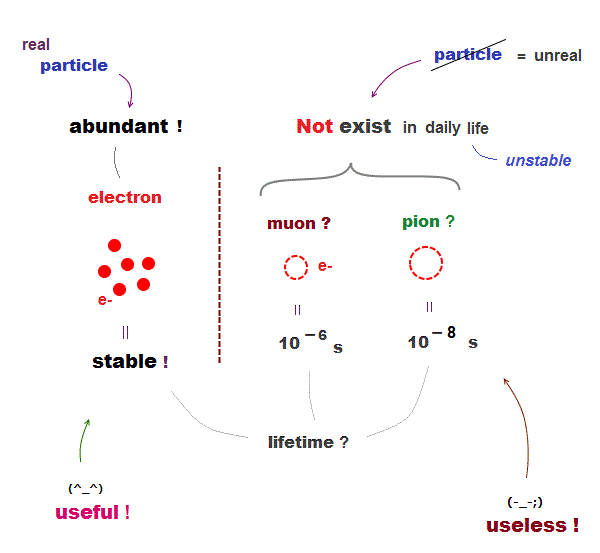
A very unstable muon, which is said to decay into an electron in only 2.2 microseconds is an unreal, unnecessary particle.
The illusory muon is said to be produced from very high-energy cosmic rays (> 1 GeV ) colliding with molecules, and be very penetrating.
We do Not need such an unstable muon that is just a electron or proton with higher energy, which can naturally penetrate material longer, which is irrelevant to the paradoxical Einstein time dilation.
Anderson just saw some charged particles in cloud chamber, and guessed those were new muons without confirming them, because the cloud chamber or particle colliders' tracks can only tell us the particle's momentum under applied magnetic field, Not energy nor mass required for identifying particles.
They baselessly guessed the patterns and lengths of tracks left in cloud chambers might indicate the (unknown) particles' energy ( loss, this-p.4-right ) or masses, based on artificial Bethe formula ( this-p.14-17, this-p.5-left-2nd-paragraph ) which often disagrees with experiment ( this-p.5-6th-paragraph ), so unreliable, No evidence of muons.
As a result, a muon is useless, unreal, unnecessary, which can be naturally explained by the high-energy electron or proton.
This-p.1-2nd-paragraph says
"If the existence of the
muon seems strange and
unnecessary to you,.. The world-famous physicist, when first told of the discovery of the muon, said in response, Who
ordered that ?"
↑ The so-called muon tomography or muography can detect only some unknown high-energy charged particles such as electrons and protons with No evidence of muons, which are useless ( this-p.3-right used just scintillators detecting some unknown charged particles, Not muons ).
Even this latest experiment (5/29/2025) allegedly generating (illusory) muons by colliding high-energy electrons with target metal did Not measure the illusory muons themselves.
↑ This research paper ↓
p.6-Figure.1 says "(illusory) Muons were then collected by two scintillator detectors (= scintillators just detect light, cannot detect muon itself )"
p.7-2nd-paragraph~p.8-1st-paragraph says "The liquid scintillator detectors were equipped with Microchannel Plate (MCP) photomultiplier tubes (MCP-PMT = detecting just photons or lights, Not muons )"
"Those generated muons come to a stop..., decaying into electrons/positrons and neutrinos. While neutrinos can freely exit the detection area, electrons are detectable by the MCP-PMTs (= just detected light emitted by electrons, Not muons ), indicating the muon decaytime"
p.25-last-paragraph says "The conversion target, lead shielding, and liquid scintillator detector used in the experiment were all modeled.... to avoid computing a large number of electromagnetic shower processes unrelated to muons"
↑ So they just measured lights emitted from some unknown high-energy particles such as electrons with a lot of unrelated background noise, ions, and relied on artificial model to imagine the illusory muons.
(Fig.6) The illusory muon's lifetime has No experimental evidence.
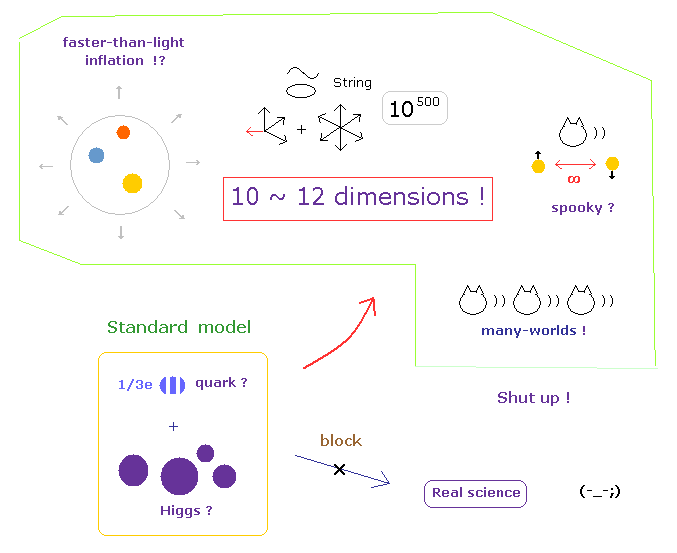
The illusory muon's lifetime is needed to predict the paradoxical W boson's mass.
But actually, the muon's lifetime experiments do Not measure the real muon's lifetime.
They baselessly imagine that when a cosmic high-energy muon hits the material, this stopping muon may emit light and decay into an electron that also emits light detected by scintillators with photodetectors (= PMT, this-p.4-5, this-p.6, this-p.4-5 ).
↑ The time interval between these two lights emitted from some (unknown) charged particles or background light is falsely treated as a (illusory) muon's lifetime, so No evidence of muons or the (paradoxical) Einstein time dilation.
Actually, this method cannot measure low-energy muons (= co comparison of lifetimes in different muons with different energies is impossible, this-p.12, p.15-last )
(Fig.7) Muon's magnetic moment experiments just measure electrons, Not (illusory) muons.
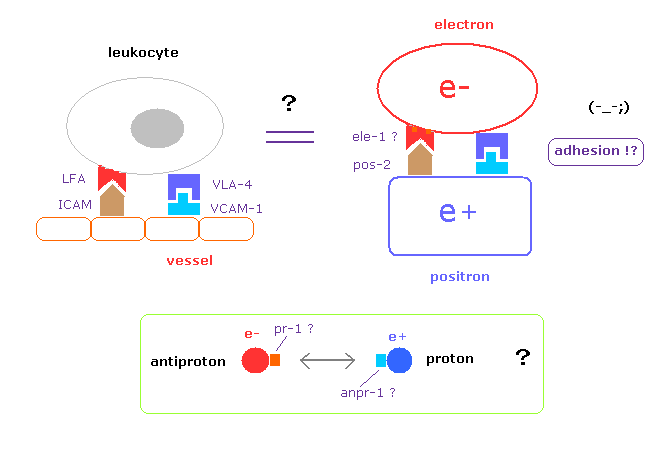
Also in experiment of muon's magnetic moment or g-2, physicists just measured lights emitted from some unknown charged particles such as electrons (= Not muons ) allegedly generated from (illusory) muons and proton collision ( this-middle, this-p.11 ).
So there is No evidence of the muons that can Not be isolated ( this-6th-paragraph ).
(Fig.8) Energy of a muonium (= positive muon + an electron ) is almost the same as an ordinary hydrogen atom ↓
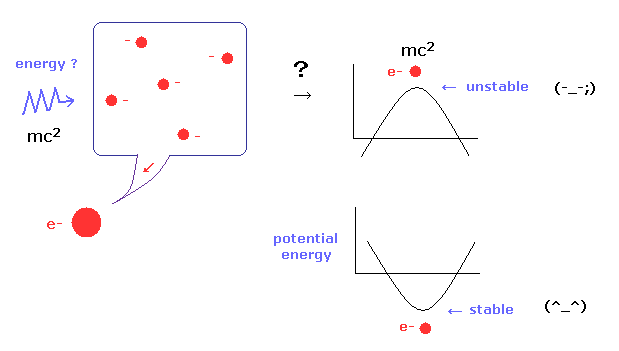
Muonium is a very unstable (illusory) atom, which is said to consist of a positive muon and an electron whose ionization energy (= 13.539 eV ) is almost the same as an ordinary hydrogen H atom (= 13.598 eV, this-p.2, this-p.2-table2 ). ← So abundant H atoms are mistaken for illusory muoniums.
A (illusory) muonic hydrogen is said to consist of a proton and a negative muon whose ionization energy is about 2 keV due to a muon's mass being 200 times larger than an electron's mass.
Physicists claim they could measure these atomic energies of the (illusory) muonium and muonic hydrogen.
But generation of these (illusory) muonium and muonic hydrogen needs very large energies (= collided protons' GeV-energy, this-p.16, illusory muon's kinetic energy > 5 keV, this-p.1-left-last-paragraph, this-p.2-left-1st-paragraph, this-p.3-2nd-paragraph, this-p.37(or p.13)-2nd-paragraph ) which high energy (= GeV = 1000000 eV ) far exceeds and easily masks the illusory muonium's (= only 13.539eV ) and muonic hydrogen's smaller energies (= only 2 keV ),
↑ Such extremely-high energy required for producing (illusory) muons generates many irrelevant background particles and energies ( this-p.8 ), which can be easily mistaken for the illusory muonium or muonic hydrogen's energies ( this-p.3-4 ).
Very unstable (illusory) muonic atoms such as muonic hydrogen (= a proton + a muon heavier than an electron ? ) is said to emit atomic energy (= several keV or X-ray ) about 200 times larger than normal atomic energies (= eV ) consisting of nuclei and lighter electrons.
But generating such (illusory) muonic atoms or muonic hydrogens needs energies far larger than the illusory muonic atomic energies, so a lot of high-energy background light or X rays causes these illusory muonic atoms.
In a (illusory) muonic hydrogen's experiment ( this-p.2-Figure 1 and p.2-left ), they used a muon with more than 5 keV kinetic energy to observe 2 keV X-ray allegedly emitted from the (illusory) muon's energy 2p → 1s transition, which was masked by the 5keV larger initial energy (= so distinguishing the muon's atomic energy to identify the muon is impossible due to the higher-energy background light ).
This research on the illusory muonic helium-p.6-right-1st~2nd-paragaphs say
"we detect the Lyman-α X-ray from the
subsequent decay to the ground state via 20 large-area
avalanche photodiodes (LAAPDs, this-p.2-right-4th-paragraph )"
"We exclude most of the background by (artificially) selecting only events with an energy in a range of [7.9, 8.5] keV"
↑ So they just artificially selected some energy values (= 7.9 ~ 8.5 keV ) allegedly representing the (illusory) muonic helium from a lot of irrelevant background X-rays, instead of really detecting or distinguishing the muonic helium.
And the detection efficiency of this large-area avalanche photodiodes (= LAAPDs measuring numbers of excited electrons instead of directly measuring the wavelength of X rays, this-p.5 ) is very bad, lower than just 50% ( this-p.1-right-1st-paragraph ), which can Not precisely measure or distinguish the (illusory) muonic atomic energies from a lot of irrelevant background lights.
(Fig.9) QCD relies on fictional virtual quark model with imaginary time and many free parameters that cannot predict anything.
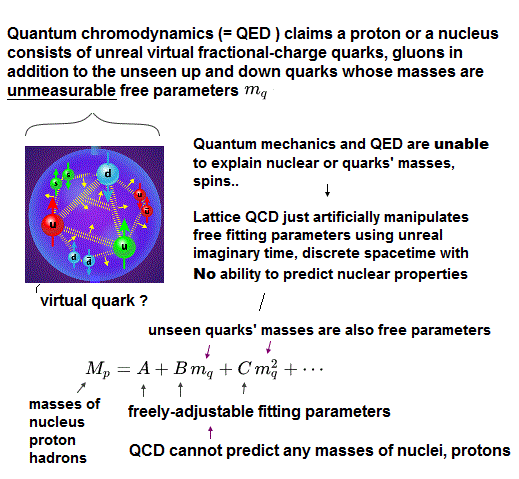
The present unphysical particle physics or standard model claims that a proton and a neutron consist of (fictional) unseen virtual quarks with fractional charges that lack experimental or theoretical evidence.
Quantum electrodynamics (= QED = perturbation theory ) is wrong, unable to remove ( meaningless ) infinities of nuclear strong force's calculations ( this-p.1-abstract ).
So the present quantum mechanics or QED can Not give nor predict any analytical values related to nuclei, protons and neutrons (= masses and spins related to nuclear strong or gluon force, this-p.8, this-3rd-paragraph ).
Physicists started to rely on the ad-hoc unphysical quantum chromodynamics (= non-perturbative lattice QCD lacking analytical solutions, this-p.1-right-last-paragraph, this-p.1-2nd-paragraph ) that just artificially adjusts many free parameters such as unseen quarks' masses, scaling parameters with No ability to predict any nuclear values such as (illusory) hadron, meson masses ( this-p.7.8,p.18-left,p.31-32, this-p.2 ) and proton spin.
This-p.13 says
"The mass scale is a (free) parameter. QCD itself does Not determine what is the mass the proton"
This-p.2-left-2nd-paragraph says
"The two parameters 𝜆1 and 𝜆2 are nonperturbative
parameters of QCD and can be estimated by fitting the
theoretical and experimental data" ← No QCD prediction.
This-p.16-last-paragraph says
"Of course, there are far too many unknown parameters"
↑ When the lattice QCD tries to extract the mass (= M or m ) of some particle (= such as hadron, meson, nucleus ) from the correlation function (= G or C ) consisting of artificially-chosen particle wavefunction and action (= energy ) by fitting ( this-p.22-23, p.29-right = multiple free fitting parameters besides mass M parameter are used, so this is Not prediction of mass ), they can adjust free parameters called smearing functions attached to the chosen particle wavefuntions ( this-p.8, this-p.25-right, this-p.6, this-p.20-C-p.22, this-p.18-left ), which is Not prediction.
As shown in this-p.22,p.29, QCD tries to guess (fictitious) mass M (= or Meff or MX.. ) from the ratio of correlation functions (= ln G(t+a)/G(t), G(t) = Ae-Mt where mass M is expressed by multiple freely-fitting parameters ) which exponential (= correlation G ) functions become almost 0 when the time t → ∞ regardless of mass M, which means they can freely choose mass M parameters (= almost ln 0/0 which mass values are fluctuating to various values in slightly-different G, from which artificial mass values can be freely chosen ), which is Not prediction of QCD.
This lattice QCD tries to describe (illusory) virtual quarks and gluon strong force by discontinuous space and imaginary time ( this-p.15 ) violating Einstein relativistic continuous spacetime ( this-p.3-Figure.2 ).
And QCD just estimates these virtual quarks or gluons' energies just by outputting random meaningless numbers in Monte-Carlo method ( this-p.11-12, this-p.4-2nd~5th-paragraphs, this-p.19 ) which random motions (= QCD random numbers ) can Not predict any physical values, unless many free parameters and models are artificially adjusted or fitted ( this-p.8 ).
This-p.8-4th-last-paragraph says
"On the other hand, in QCD, we are unable to explain rigorously even basic phenomena
like colour confinement, and perturbative calculations rely upon unproven assumptions"
See also this-p.39-41, p.46-(24)
Instead of today's unrealistic virtual quark model that is unobservable, we can naturally think the nuclear strong force is just short-distance Coulomb force between electrons inside neutrons and protons inside nuclei.
↑ This realistic short-distance Coulomb nuclear binding force can naturally explain non-existent Helium-2 whose nucleus consists only of two positive protons without neutrons (= electrons ) and Lithium-3 whose nucleus consists only of three positive protons.
(Fig.10) Anderson detected just a proton ejected by cosmic rays, Not a positron in cloud chamber.
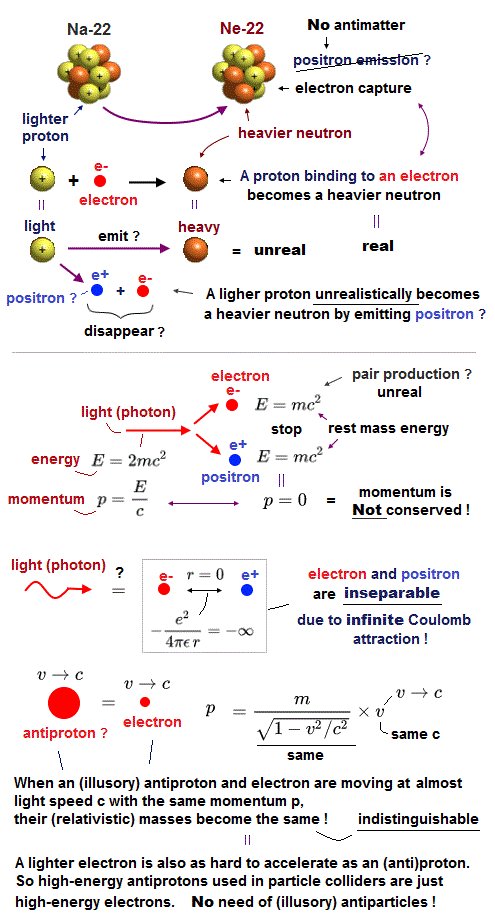
Antimatter, antiparticles such as positrons, antiprotons, antiquarks.. are unreal (= Not a real theory ), unphysical, unnecessary, if we consider PET uses the realistic electron capture instead of the paradoxical positron emission
It is said that Anderson discovered an antiparticle called positron in cloud chamber under applied magnetic field in 1932.
But the cloud chambers, which just leave some static tracks, can Not identify or distinguish (illusory) rare antiparticles from other more abundant protons or electrons.
What Anderson detected was just a high-energy penetrating proton ejected by the high-energy cosmic rays instead of a (illusory) positron.
Actually, Nobel laureates Bohr and Millikan did Not believe Anderson's claim of discovering a positron, as this-p.7-right-3rd-paragraph saying
"Millikan had dismissed Anderson's original conclusions (= of a positron ) on the
same ground."
Anderson just wildly guessed that it might be a new positron instead of a proton only from seeing the particle's track's length (= related to how fast the particle loses energy and how much energy it has ) without confirming the positron ( this-p.12-lower, this-p.7 ).
↑ A high-energy proton generated by the high-energy cosmic rays is more likely to move longer (= causing thinner, longer track ) in cloud chamber than the ordinary slower protons on the earth, which was mistaken for a (illusory) positron.
(Fig.11) The illusory paradoxical positron emission can be replaced by the real electron capture.
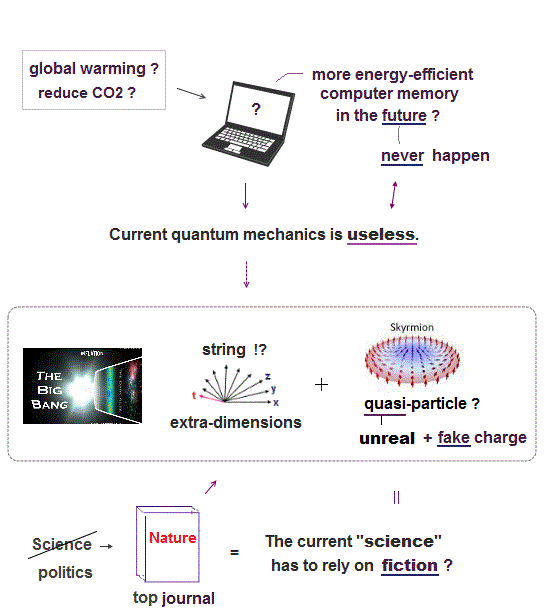
The only practical use of the (illusory) antiparticles is said to be the positron emission tomography or PET, which is wrong.
Actually this PET uses the realistic electron capture (= EC ) instead of the illusory positron emission (= β+ ), because both the realistic electron capture and the illusory positron emission cause the same nuclear reaction changing a proton into a neutron ( this-p.99 ).
The positron emission (= beta+ plus decay ) where a lighter proton emits a heavier neutron and a positron is paradoxical and unreal.
On the other hand. in the realistic electron capture, a lighter proton captures an electron to become a heavier neutron, which is quite natural.
Na-22 radioactive atom is said to change into Ne-22 by either a (illusory) positron emission (= e+ ) or an electron capture by emitting γ rays whose energy is bigger than 2mc2 = 1.022 MeV where m is the electron ( positron ) mass ( this-p.9-Figure.6 ).
The realistic electron capture is more universal, because when the energy difference involved in the nuclear reaction is less than 2mc2 (= m is electron mass, ), the positron emission is impossible, and the electron capture is the only solution ( this-p.6-2nd-last-paragraph ).
This says "If the energy difference between the parent atom and the daughter atom is less than 1.022 MeV (= 2mc2 ), positron emission is forbidden, and electron capture is the sole decay mode. For example, Rubidium-83 will decay to Krypton-83 solely by electron capture (the energy difference is about 0.9 MeV)."
↑ So the positron emission is unphysical and unnecessary.
The realistic electron capture alone can explain all these nuclear reactions.
γ rays detectors such as NaI can not detect γ rays themselves, instead, they can detect only visible lights allegedly emitted by atoms excited by γ rays ( this-p.3-2nd-paragraph, this-p.22-1st-paragraph, this-p.2 ), which detectors are prone to irrelevant background lights, making it difficult to precisely know the original γ ray's energy allegedly emitted by (illusory) antiparticles.
(Fig.12) Antiparticles are unreal, impossible to generate.
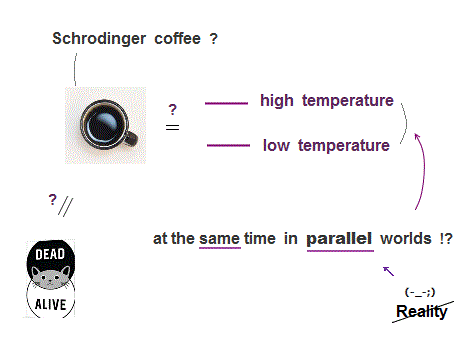
In fact, antiparticles disobey the physical principle such as Coulomb electric force and momentum conservation, so unreal.
When the initial light with momentum generates a pair of a stationary electron and a stationary positron with No momentum, the total momentum is Not conserved.
↑ So they baselessly say a pair production of a (illusory) positron and an electron from a light needs a heavy nucleus that can absorb only the momentum of the initial light ( this-p.20 ). ← But absorbing only the momentum without energy is impossible.
And producing the stationary positron and electron needs the light to transiently stop, which is prohibited by Einstein relativity where the light must always travel at light speed c.
↑ So today's particle physics unrealistically says the fictional virtual photon disagreeing with relativistic energy-mass relation ( this-p.4 ) is needed to generate an (illusory) antiparticle and a particle ( this-p.16-last ).
Furthermore, when the neutral initial light generates a electron and a positron, it needs infinite amount of energies to separate a negative electron from a positive positron which attract each other by infinite Coulomb attraction (= distance between a electron and a positron is zero inside the initial neutral light ).
As a result, a pair production of an antiparticle and particle from the initial neutral (virtual) light is impossible due to antiparticles disobeying the physical principle.
When an antiparticle and a particle attract and accelerate each other by changing the Coulomb attractive potential energy into kinetic energy, this kinetic energy eventually emitted as light needs to be accumulated as potential energy in the medium surrounding those particles in advance, which disagrees with Einstein relativity and its unphysical relativistic Dirac equation of antiparticles.
(Fig.13) Particle colliders do Not distinguish a (illusory) positron from a proton, an (illusory) antiproton from an electron.
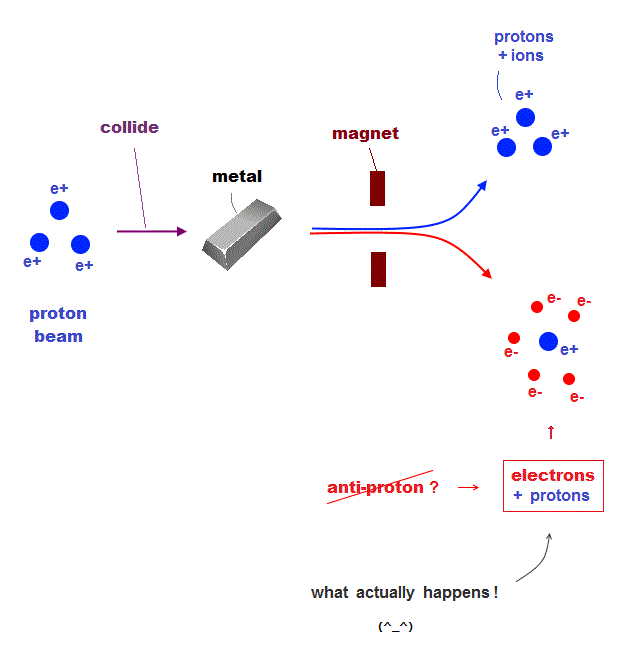
In fact, today's particle colliders can Not distinguish a (illusory) positron from a real proton inside the positive ions under magnetic field.
↑ An illusory positron (= e+ ) is said to be produced by the accelerated high-energy electrons colliding with target atoms ( this-p.2 ), but they just vaguely distinguish positive and negative ions only under magnetic field, which can Not distinguish a (illusory) positron from a proton ( this-p.4 ).
↑ The accelerated electrons used for producing positrons have energy large enough to break the target atomic nuclei to produce protons (= or neutrons, ← antineutrino is just ordinary neutrino, because they have the same neutral charge, cannot be distinguished ).
Particle colliders also can Not distinguish a illusory antiproton from a much more abundant electron inside negative ions.
↑ Antiprotons are said to be produced by the accelerated protons colliding with target metals, but they just vaguely separate positive and negative ions only under magnetic field which can only distinguish (unknown) particles' momentums, can Not distinguish antiprotons from other abundant electrons ( this-p.23, this-p.2 ).
Antiprotons are kept with extremely high kinetic energy (> GeV ), where even electrons with more than 1 GeV can have the same large (relativistic) mass (= actually Maxwell's mc2 instead of paradoxical relativity ) as the proton's (= or antiproton's ) mass (= 1 GeV ), which can be mistaken for the illusory antiproton ( this-p.6, this-p.3-left, this-p.3 ).
↑ It is impossible to precisely measure any atomic energy or very small magnetic moment of the illusory antiparticles due to larger background energy needed to produce antiparticles easily masking them ( this-p.2 ).
Production of the illusory rare antiparticles are always accompanied by producing much more abundant particles such as electrons, protons, γ rays, ions which abundant particles can be scattered and easily mistaken for the (illusory) unstable antiparticles, antihydrogen ( this-p.8 ) whose energy is the same as the ordinary hydrogen, and (illusory) positronium ( this-p.3-right )..

Feel free to link to this site.